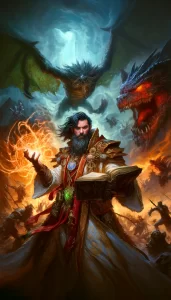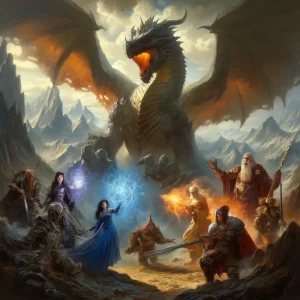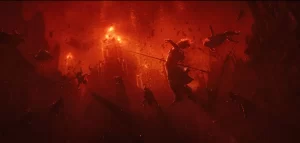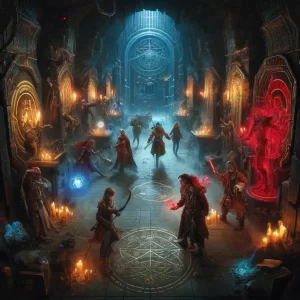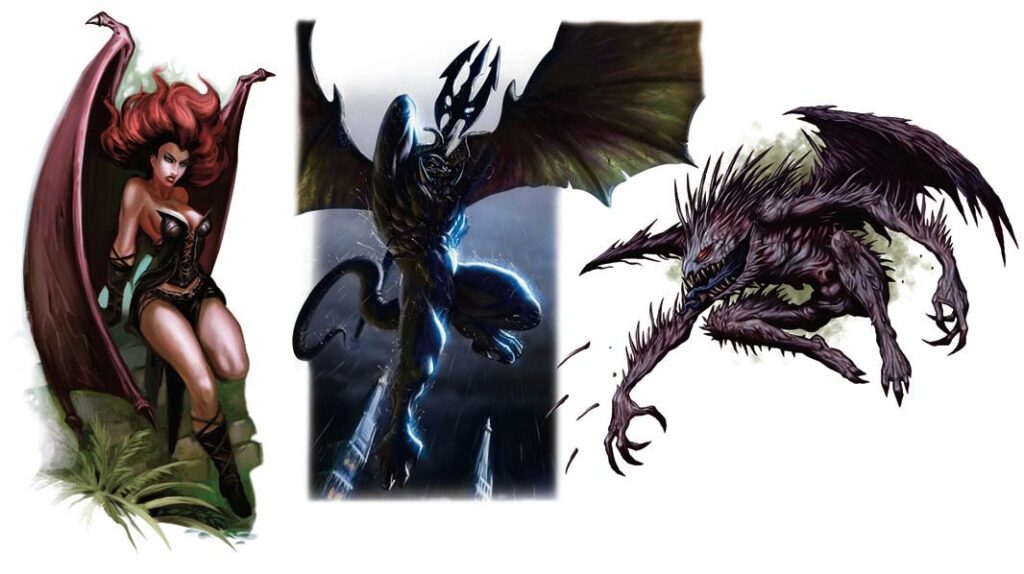
In the shadowed annals of the cosmos, there lies a horrifying realm, a place of dread and malice, known to mortals as The Nine Hells, or Baator. This chilling inferno was once the dominion of the Baatorians, enigmatic and fearsome creatures that ruled with a hierarchy as complex and cold as the devils that would one day usurp them.
In the nascent era of the multiverse, a time veiled in myths and secrets, the gods began the grand work of shaping and populating the planes. This endeavor ignited celestial conflicts, fierce and unrelenting, staining the heavens with divine wrath. Corellon and Gruumsh clashed in a cataclysmic battle that birthed races from their very essence: from Corellon's sorrowful tears, the elves arose, and from Gruumsh's blood, the orcs were forged.
He Who Was, the deity of humans, known by some as He Who Lit Our Way, crafted humanity in his enigmatic image. A deity both benevolent and tyrannical, he amassed a legion of angelic servants, guardians of justice and virtue. Among these celestial beings were names that would later send chills down the spines of mortals: Asmodeus, Malcanthet, Mephistopheles, Geryon-entities destined to become some of the most dreadful villains in the multiverse.
Asmodeus, a being of unparalleled strength and skill, was once the shining champion of his god. But as the epochs wore on, his efficiency curdled into merciless brutality. In a human conflict that raged like a storm, he wrought a massacre, a slaughter where innocent blood mingled with the guilty. This act of savagery led to his fall from grace, a demotion that marked the beginning of a dark transformation.
Faced with his own remorse and humiliation, Asmodeus sought redemption, devoting himself anew to the principles of protection, virtue, and chastity. His penance was to stand guard over the prison of Tharizdun, the mad god, a duty that would lead him down a path to damnation.
Pazuzu, an ancient obyrith and demon lord, began to visit the once-holy sentinel. The obyriths were demons of such eldritch terror that they predated gods and mortals alike; their very forms could fracture the mind of those who gazed upon them, and the cosmos itself trembled at their existence. Pazuzu's whispers were like venomous tendrils, corrupting Asmodeus' mind, sowing the seeds of doubt, rebellion, and ambition.
The celestial warrior's faith in his god waned. He Who Was's imperfections became more glaring: his unfaithful nature, his coldness towards humanity, his creation of beings solely for servitude. The seed of evil, buried deep in the heart of the Abyss by obyriths like Pazuzu, began to whisper to Asmodeus, seducing him with promises of power and liberation.
In a forbidden act, Asmodeus shattered a shard from this seed of malevolence, embedding it in his scepter. The shard blackened his soul, consuming him with corruption, and he set out to gather an army, recruiting disgruntled celestial knights and angels, swaying them with his fervor, his vision of a new cosmic order.
Among his allies were the Succubus Queens, Malcanthet and Lilith, lured by promises of pure, chaste love. With deceit and manipulation, he played them against each other, binding them to his cause.
The rebellion culminated in a series of bloody battles, celestial wars that resonated throughout the planes. The Battle of Blood-Dimmed Stars ended with a victory for the loyalists, but it was a hollow triumph, tainted by the defection of Alloces, an angel who reveled in torture, and Geryon, who betrayed He Who Was to join Asmodeus.
A key turning point was the betrayal of Bensozia, one of He Who Was's wives, seduced by Asmodeus's promises. The lord of imps, Beleth, a traitor hidden amongst the ranks of the loyalists, provided vital intelligence to the rebels, ultimately abandoning his god to stand with Asmodeus.
The rebellion twisted the fabric of the cosmos, reshaping the very nature of The Nine Hells, and leaving a legacy of treachery, pain, and horror. The once-noble Asmodeus became a symbol of tyranny, a fallen angel whose ambition knew no bounds.
Today, the story lingers like a haunting melody, a cautionary tale of power and corruption. The names that were once synonymous with virtue and justice now evoke fear and revulsion. The dark history of The Nine Hells remains a chilling testament to the thin line that separates good from evil, a line that, once crossed, can lead to the very depths of damnation.
Most prominent angels known to have joined Asmodeus in the rebellion:
| Mephistopheles | Graz'zt | Malcanthet | Lilith |
| Triel (Baalzebul) | Levistus | Belial | Naome |
| Mammon | Moloch | Dispater | Gargoth |
| Beleth | Bensozia | Bathym | Malarea |
| Geryon | Amon | Batna | Beherit |
In a final, world-shattering battle, Asmodeus mortally wounded He Who Was. The god cursed Asmodeus with his dying breath, imprisoning him and the traitors in Baator (The Nine Hells) forever.
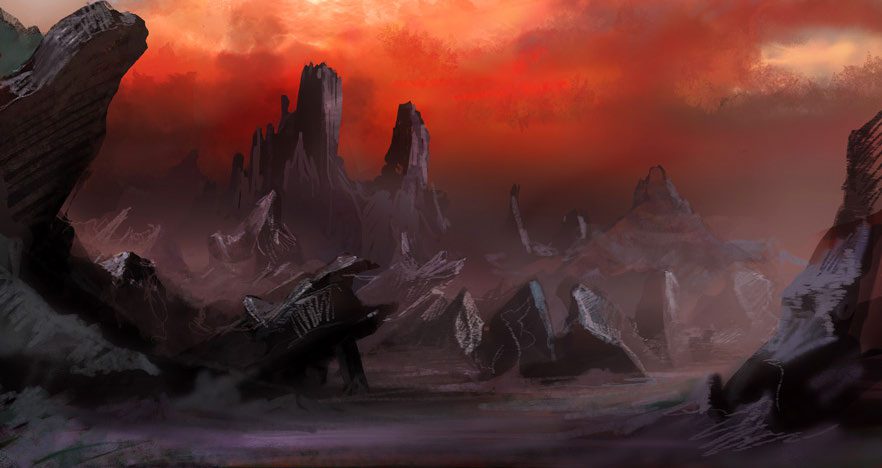
In the shadowed annals of the cosmos, there lies a horrifying realm, a place of dread and malice, known to mortals as The Nine Hells, or Baator. This chilling inferno was once the dominion of the Baatorians, enigmatic and fearsome creatures that ruled with a hierarchy as complex and cold as the devils that would one day usurp them.
In the nascent era of the multiverse, a time veiled in myths and secrets, the gods began the grand work of shaping and populating the planes. This endeavor ignited celestial conflicts, fierce and unrelenting, staining the heavens with divine wrath. Corellon and Gruumsh clashed in a cataclysmic battle that birthed races from their very essence: from Corellon's sorrowful tears, the elves arose, and from Gruumsh's blood, the orcs were forged.
He Who Was, the deity of humans, known by some as He Who Lit Our Way, crafted humanity in his enigmatic image. A deity both benevolent and tyrannical, he amassed a legion of angelic servants, guardians of justice and virtue. Among these celestial beings were names that would later send chills down the spines of mortals: Asmodeus, Malcanthet, Mephistopheles, Geryon-entities destined to become some of the most dreadful villains in the multiverse.
Asmodeus, a being of unparalleled strength and skill, was once the shining champion of his god. But as the epochs wore on, his efficiency curdled into merciless brutality. In a human conflict that raged like a storm, he wrought a massacre, a slaughter where innocent blood mingled with the guilty. This act of savagery led to his fall from grace, a demotion that marked the beginning of a dark transformation.
Faced with his own remorse and humiliation, Asmodeus sought redemption, devoting himself anew to the principles of protection, virtue, and chastity. His penance was to stand guard over the prison of Tharizdun, the mad god, a duty that would lead him down a path to damnation.
Pazuzu, an ancient obyrith and demon lord, began to visit the once-holy sentinel. The obyriths were demons of such eldritch terror that they predated gods and mortals alike; their very forms could fracture the mind of those who gazed upon them, and the cosmos itself trembled at their existence. Pazuzu's whispers were like venomous tendrils, corrupting Asmodeus' mind, sowing the seeds of doubt, rebellion, and ambition.
The celestial warrior's faith in his god waned. He Who Was's imperfections became more glaring: his unfaithful nature, his coldness towards humanity, his creation of beings solely for servitude. The seed of evil, buried deep in the heart of the Abyss by obyriths like Pazuzu, began to whisper to Asmodeus, seducing him with promises of power and liberation.
In a forbidden act, Asmodeus shattered a shard from this seed of malevolence, embedding it in his scepter. The shard blackened his soul, consuming him with corruption, and he set out to gather an army, recruiting disgruntled celestial knights and angels, swaying them with his fervor, his vision of a new cosmic order.
Among his allies were the Succubus Queens, Malcanthet and Lilith, lured by promises of pure, chaste love. With deceit and manipulation, he played them against each other, binding them to his cause.
The rebellion culminated in a series of bloody battles, celestial wars that resonated throughout the planes. The Battle of Blood-Dimmed Stars ended with a victory for the loyalists, but it was a hollow triumph, tainted by the defection of Alloces, an angel who reveled in torture, and Geryon, who betrayed He Who Was to join Asmodeus.
A key turning point was the betrayal of Bensozia, one of He Who Was's wives, seduced by Asmodeus's promises. The lord of imps, Beleth, a traitor hidden amongst the ranks of the loyalists, provided vital intelligence to the rebels, ultimately abandoning his god to stand with Asmodeus.
The rebellion twisted the fabric of the cosmos, reshaping the very nature of The Nine Hells, and leaving a legacy of treachery, pain, and horror. The once-noble Asmodeus became a symbol of tyranny, a fallen angel whose ambition knew no bounds.
Today, the story lingers like a haunting melody, a cautionary tale of power and corruption. The names that were once synonymous with virtue and justice now evoke fear and revulsion. The dark history of The Nine Hells remains a chilling testament to the thin line that separates good from evil, a line that, once crossed, can lead to the very depths of damnation.



